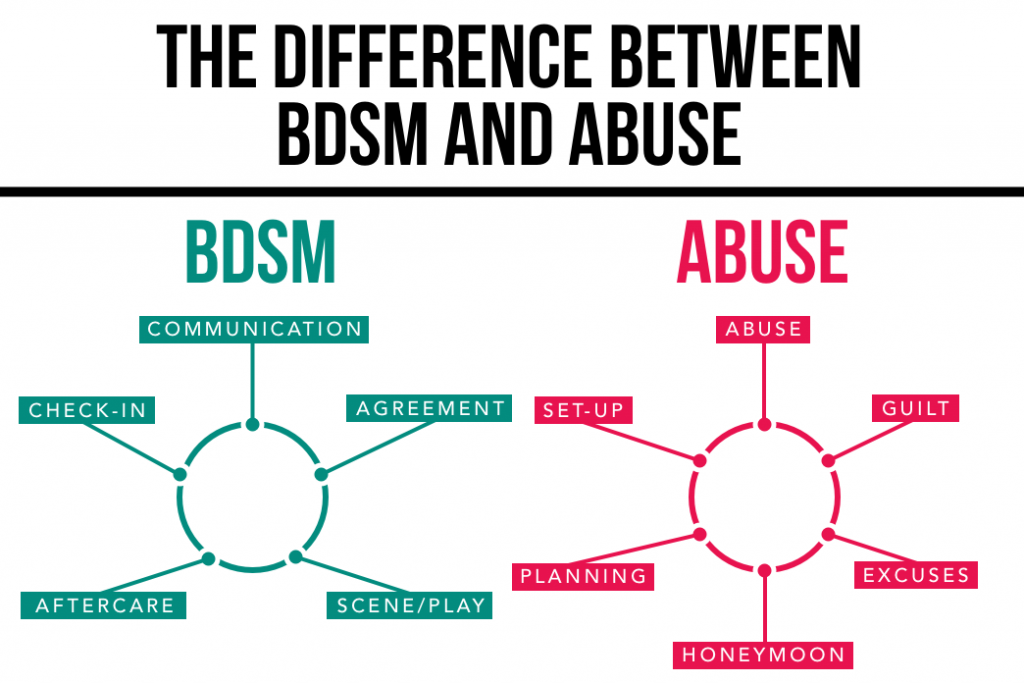How is kink different from abuse?
This is a totally fair question.
After all, many mainstream media depictions (including porn) give the impression that the person “in charge” of the scene or relationship (usually the top, dominant, master, or owner) has all of the power, and the other partner(s) are helpless, having waived their right to say “No,” or reject orders.
In the words of the famous commercial, “That’s not how this works. That’s not how ANY of this works.”
People who identify as kinky are generally doing so with the unspoken assumption of consent.
In short terms, this means that everything done in kink is negotiated and agreed to by ALL parties involved before it happens.
Let me say that again:
Everything done in kink is negotiated and agreed to by ALL parties involved before it happens.
The “all” in there is a pretty important part of the sentence. Many people focus on the bottom, receiver or submissive as the vulnerable partner, since they are the ones being acted upon. The ones ceding power, being hit, hurt, humiliated, tied up—whatever their fancy.
And that’s fair. After all, these are usually the more vulnerable parties in kink and elsewhere.
However, for something to be consensual kink, ALL parties involved must consent.
That means that even though it may not be obvious, because they seem to have all the power, the top, giver, or dominant must also consent to what is happening as well, and has just as much power (I would argue more, but that’s a different topic) to withhold consent as the bottom/receiver/submissive.

So, consensual kink, usually just referred to as “kink” by those who practice it always allows for anyone to withdraw consent at any time.
This might be by setting limits in the negotiations.
It might be by saying “No” at some point in the play.
A safeword may be negotiated to slow down or stop a scene at any point.
Usually, in kink, ways to END any play are discussed quite thoroughly, expectations are set about how ending might work, and if consent is ever withdrawn, things are ended quickly and happily.
Well, happily is an ideal.
After all, there are times when neither partner wants to end an amazing scene, but it’s required. Like a cramp, or a sudden feeling of illness, an overwhelming emotion that doesn’t belong, or digits going numb (during bondage or rope play, say).
Let’s compare and contrast consensual kink and abuse:
Kink: Using body/mental sensations such as pain, pleasure, humiliation and love to elicit pleasure and release.
Abuse: Causing physical and/or mental/emotional harm to another person.
Kink: Consensual power exchange where both partners negotiate and agree, empowering themselves within an agreed-upon framework.
Abuse: Takes away power from one partner.
Kink: Actions and relationships are communicated, negotiated, and agreed to.
Abuse: There is no agreement to when/how it will happen, and there is no consent to it happening.
Kink: Creates excitement in each partner for the other.
Abuse: Creates fear of one partner for another.
Kink: Fosters and builds trust.
Abuse: Destroys trust.
Kink: Intended to fulfill the desires and needs of all involved within a safe environment.
Abuse: Focuses on the needs and desire of just one, creating a cruel and possibly violent environment for the other.
Kink: Communication and support create an environment where it’s safe to talk about wants, needs, thoughts, and emotions.
Abuse: No support. Communication is usually one-sided (if it happens at all), and wants, needs, thoughts, and emotions are not safe.
Maybe you think you’re kinky (or know you are), and those contrasts are resonating with you.
Maybe, though, you’re reading this book because you want to understand a friend or loved one’s kink more, and really, it just still seems pretty abusive to you.
It ought to be OK to take their word that they want this, but are there ways you can be sure?
Honestly, not really. Well, not unless it’s over time.
However, there are some clues that might help, especially with the physical play and marks that can seem so scary:
There are no defense wounds. People in abusive situations will often raise their hands/arms to protect their face, and will have secondary wounds from the impact. People in kink welcome their play. There are exceptions where, for example, primal or rough body play engages the whole body. Listen for words like that when you ask after their well-being.
Concentration of “damage.” Kink can often leave some pretty scary marks, especially from paddles, “evil sticks,” whips, canes, etc. However, they are usually fairly concentrated in specific areas: buttocks, thighs, back, breasts, and genitals. Rarely will you see random areas or very public spots like the face touched in kink, except (again) in primal/rough body play.
Kinky toys. While kink can be performed with pretty much anything (there are entire groups devoted to “pervertibles,” or everyday objects you can use to make people feel something in kink—like wooden spoons, wood clamps, even tinsel), most kinky people will have at least a small collection of toys, like handcuffs, floggers, paddles, gags, etc.
Language. Kinky people have very specific language around what we do. We use the term “marks” instead of “wounds” or “scars.” “Power exchange” or “D/s” to refer to relationship dynamics. They might mention SSC, RACK or PRICK. And so on. Consent will be mentioned. A LOT.
Pride/defiance, instead of fear. Not only will kinky people mention consent, but if you question us, we will often get downright offended that you don’t think we’re telling the truth, or that we have a right to choose how to use our bodies with partners for our own pleasure and fulfillment.
HARD TRUTH: You cannot be sure.
People CAN be both kinky and abusive.
To say otherwise would be lying.
And people can THINK they are in a consensual kinky relationship, then suddenly one day realize they were lied to and emotionally abused into consenting.
That’s just life.
Nothing is ever ONLY good, including kink.
But if the kinky person is your friend or loved one, you may just have to take their word for it, and support and love them as hard as you can, even if you don’t understand.
Because that is how you will keep the relationship, and if, ever, anything turns out to go wrong (even if it’s not abuse, but just a relationship meltdown), that’s how you will be there to help them pick up and move on.
Bottom line is…
Kink is many things to many people: exciting, scary, overwhelming, exhausting, breathtaking, and more.
It should always be consensual, with everyone involved feeling like they are supported in communication and realization of their needs and desires and that they may opt-out (with no negative repercussions) at any time.
Without that feeling, it’s abuse.
It may ALSO be kinky. But being kinky does not in any way make abuse OK.








